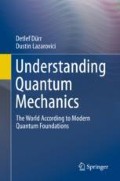Abstract
When we look in textbooks on quantum theory to find the heart of the theory, one notion in particular stands out: the observable. In older representations, observables are self-adjoint operators on the Hilbert space of a system and they are supposed to describe the properties of a system which can be observed. In more modern texts (actually already since the 1950s), the notion of observables has been extended to positive operator-valued measures (POVMs). This extension was already in-between the lines in von Neumann’s book Mathematische Grundlagen der Quantenmechanik, because von Neumann viewed observables as emerging from their spectral decompositions, which are projector-valued measures (PVMs). All these seemingly abstract things will now be explained, and we shall see why they arose in the first place. We shall find that their role in quantum theory is that of bookkeepers for the statistics produced by measurement experiments. Once that is clear, we shall be immune to the philosophical encumbrances that come to light in Chap. 9 on hidden variables.
Access this chapter
Tax calculation will be finalised at checkout
Purchases are for personal use only
Notes
- 1.
In: J.S. Bell, Speakable and Unspeakable in Quantum Mechanics (2nd edn). Cambridge University Press, 2004, p. 214.
- 2.
J. von Neumann, Mathematische Grundlagen der Quantenmechanik. Springer, 1932.
- 3.
D. Drr, S. Goldstein and N. Zanghì, Quantum equilibrium and the role of operators as observables in quantum theory. In: Quantum Physics Without Quantum Philosophy, Springer, 2013.
- 4.
We use the following terminologies interchangeably: Born’s statistical interpretation, Born’s statistical law, Born’s statistical rule. They all mean the same thing, although they sometimes emphasise different views.
- 5.
For a quick proof, read (7.6) as a quadratic form (c, Ac) = 0 with vector \(c=(c_1,\ldots , c_n)\in \mathbb {C}^n\) and the Hermitian matrix A with entries
$$\displaystyle \begin{aligned} A_{k,k'}:=\int\varphi_k^*(x) \varphi_{k'}(x)\mathrm{d}^mx= A_{k',k}^+ \,. \end{aligned}$$Then, choosing the vectors c as eigenvectors, we see that all the matrix elements must vanish.
- 6.
A joker could also write imaginary numbers on the display of the apparatus. Then the bookkeeping device \(\hat A\) with α k imaginary would no longer be self-adjoint. One should reflect upon that.
- 7.
Actually a sesquilinear form, linear in the first argument and antilinear in the second.
- 8.
See, however, Remark 7.5.
- 9.
In the sense of measure theory.
- 10.
Consider the Fourier transform
$$\displaystyle \begin{aligned} \hat{\tilde\rho}=\mathbb{E}(\mathrm{e}^{\mathrm{i} \mathbf{\alpha}\cdot\tilde{\mathbf{X}}})= \mathbb{E}(\mathrm{e}^{\mathrm{i} \mathbf{\alpha}\cdot(\mathbf{X}+\mathbf{Y})})= \mathbb{E}(\mathrm{e}^{\mathrm{i} \mathbf{\alpha}\cdot\mathbf{X}}) \mathbb{E}(\mathrm{e}^{\mathrm{i} \mathbf{\alpha}\cdot\mathbf{Y}})=\widehat{|\varphi|{}^2}\cdot\widehat p\,, \end{aligned}$$and note that the Fourier transform of a product is a convolution, as is easily checked.
- 11.
For a recent such proposal, see Siddhant Das and Detlef Drr, Arrival time distributions of spin-1/2 particles, Scientific Reports 9, 1–8 (2019).
- 12.
The section title here is taken from a remark made by Einstein to Heisenberg, quoted from Physics and Beyond: Encounters and Conversations. A.J. Pomerans, trans. (Harper and Row, New York, 1971), Chap. 5.
- 13.
Translated by the authors from Bruno Snell (Hg.), Fragmente: Griechisch - Deutsch (Sammlung Tusculum). Artemis & Winkler, 2007, p. 29.
Author information
Authors and Affiliations
Rights and permissions
Copyright information
© 2020 Springer Nature Switzerland AG
About this chapter
Cite this chapter
Dürr, D., Lazarovici, D. (2020). The Measurement Process and Observables. In: Understanding Quantum Mechanics . Springer, Cham. https://doi.org/10.1007/978-3-030-40068-2_7
Download citation
DOI: https://doi.org/10.1007/978-3-030-40068-2_7
Published:
Publisher Name: Springer, Cham
Print ISBN: 978-3-030-40067-5
Online ISBN: 978-3-030-40068-2
eBook Packages: Physics and AstronomyPhysics and Astronomy (R0)

